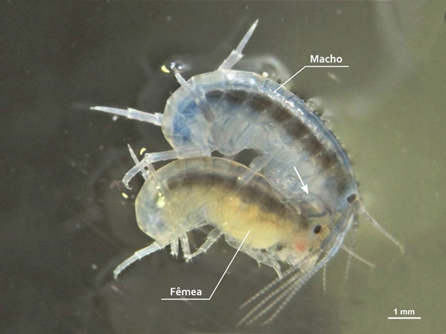

The Parhyale hawaiensis species measures around 10 millimeters, lives in shallow waters or intertidal regions, and is distributed globally in tropical regions (image: Marina Tenório Botelho)
The platform, developed at the State University of Campinas, uses the small crustacean Parhyale hawaiensis to determine if a substance can damage sperm DNA and affect fertility.
The platform, developed at the State University of Campinas, uses the small crustacean Parhyale hawaiensis to determine if a substance can damage sperm DNA and affect fertility.

The Parhyale hawaiensis species measures around 10 millimeters, lives in shallow waters or intertidal regions, and is distributed globally in tropical regions (image: Marina Tenório Botelho)
By Ricardo Muniz | Agência FAPESP – A research group from the State University of Campinas (UNICAMP) in Brazil has validated an innovative test that does not require the use of mammals to detect DNA damage. Their work was published in the journal Science of The Total Environment.
Chemical compounds can damage the genetic material of sperm, leading to reduced fertility and smaller populations. When registering chemical substances, this danger is assessed by means of mandatory laboratory tests. Classic procedures use mammals but have been replaced by new approach methods (NAMs). For example, methodologies that use vertebrates are already prohibited for the evaluation of cosmetics.
Since 2010, the Laboratory of Ecotoxicology and Genotoxicity (LAEG) at the School of Technology at UNICAMP has been developing an alternative platform for toxicity tests using Parhyale hawaiensis, a small invertebrate amphipod (from the order of small crustaceans) that lives in shallow waters or intertidal regions and is distributed globally in tropical regions. As an adult, it measures around 10 millimeters, has 23 pairs of chromosomes, and has a genome that is 30% larger than that of humans.

Test platform developed at UNICAMP (photo: Marina Tenório Botelho)
“It’s been used as a model in evolution and development studies and was introduced by our research group as a test organism in toxicity assessments,” says Gisela de Aragão Umbuzeiro, who has a PhD in genetics and molecular biology from UNICAMP, an associate professorship in toxicology from the University of São Paulo (USP), and a postdoctoral internship at the National Institute of Environmental Health Sciences (NIEHS) and the Environmental Protection Agency (EPA) in the United States.
“P. hawaiensis has the advantage of developing easily in laboratory cultivation, using little space and producing many organisms every week,” adds Umbuzeiro, who coordinates a project funded by FAPESP.
The developed tests are miniaturized to generate minimal waste and use small sample amounts. Different protocols can measure cell death, reproduction, and genetic damage in the “blood” (called hemolymph) of P. hawaiensis.
Marina Tenório Botelho, a postdoctoral student in Umbuzeiro’s group and a FAPESP scholarship holder, managed to dissect the males to remove the testicles and optimized a method to detect genetic damage in the animals’ sperm.
This method is called the comet assay. After placing the sperm on a glass slide with gel, treatments are carried out so that only the genetic material (DNA) of the cells remains in the gel. Then, an electric current is applied to the slides, causing smaller pieces of DNA (indicating breaks) to move faster than larger pieces of intact, lesion-free DNA, creating a comet-like appearance. Finally, a fluorescent dye is applied to the slides, and the migration behavior of the genetic material is observed under a microscope at 400x magnification.

Cometa test (image: Marina Tenório Botelho)
In the published article, the test was validated using mutagenic compounds as proof of concept, such as ethylmethanesulfonate and benzo[a]pyrene. “We observed that when adult males were exposed for 24 to 96 hours, it was possible to detect DNA damage in the spermatozoa that increased in relation to the exposure concentration,” Umbuzeiro explains.
The test could potentially be used in the future to assess genotoxicity in germ cells, indicating the ability of chemical compounds to reach the testicles of organisms and damage genetic material. New studies are underway to develop a protocol for assessing damage to the ovarian cells of exposed organisms.
The article “Designing and applying a methodology to assess sperm cell viability and DNA damage in a model amphipod” can be read at www.sciencedirect.com/science/article/abs/pii/S0048969724054688.
Republish
The Agency FAPESP licenses news via Creative Commons (CC-BY-NC-ND) so that they can be republished free of charge and in a simple way by other digital or printed vehicles. Agência FAPESP must be credited as the source of the content being republished and the name of the reporter (if any) must be attributed. Using the HMTL button below allows compliance with these rules, detailed in Digital Republishing Policy FAPESP.





